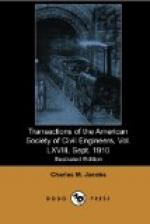This paper has for its subject the New York Tunnel Extension project, and is intended merely as an introduction to the detailed accounts of the construction of the various divisions of the line to be given in succeeding papers prepared by the engineers who actively carried out the work. The project, however, forms the most important part of the comprehensive scheme adopted by the Pennsylvania Railroad Company for conducting its traffic into and through New York City, and a brief description of this general plan is therefore necessary in order that the relations of the tunnel line to the other parts of the transportation project may be clearly understood.
GENERAL PLAN FOR TRAFFIC FACILITIES AT NEW YORK.
The component elements of the general plan outlined by the late A. J. Cassatt, President, in his open letter to the Board of Rapid Transit Railroad Commissioners of the City of New York, dated January 18th, 1906, are indicated on Fig. 1, and may be briefly summarized as follows:
1.—The Pennsylvania Tunnel and Terminal Railroad, generally referred to as the New York Tunnel Extension of the Pennsylvania Railroad. This line begins near Newark, N. J., crosses the Hackensack Meadows, and passes through Bergen Hill and under the North River, the Borough of Manhattan, and the East River to the large terminal yard, known as Sunnyside Yard, in Long Island City, Borough of Queens, New York. The line will be more fully described elsewhere.
2.—The electrification of the Long Island Railroad within the city limits.
3.—The Pennsylvania freight terminal yard and piers at Greenville, N. J., connecting by ferry with the Bay Ridge terminal of the Long Island Railroad.
4.—The Bay Ridge Improvement of the Long Island Railroad from East New York to Bay Ridge.
5.—Yards for increasing the freight facilities in the Boroughs of Brooklyn and Queens.
6.—The Atlantic Avenue Improvement in Brooklyn, involving the removal of the steam railroad surface tracks and the extensive improvement of the passenger and freight station at Flatbush Avenue.
7.—The New York Connecting Railroad, extending through a part of the Borough of Queens and crossing the East River by a bridge at Ward’s and Randall’s Islands to Port Morris, N. Y.
8.—The Glendale Cut-Off of the Long Island Railroad.
9.—New piers and docks in Newtown Creek at its confluence with the East River.
10.—Electrification of the United Railroads of New Jersey Division from Newark to Jersey City.
The parts sustained by these elements in the work of transportation and distribution are briefly as follows:




